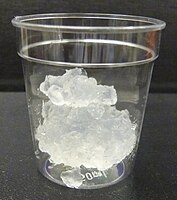
Photo from wikipedia
Nano-fibrillated celluloses (NFCs) were separated from bleached softwood kraft pulp. Through the periodate oxidation method, 2,3-dialdehyde nano-fibrillated celluloses (DNFCs) with varied aldehyde content were prepared. The high aldehyde content, large… Click to show full abstract
Nano-fibrillated celluloses (NFCs) were separated from bleached softwood kraft pulp. Through the periodate oxidation method, 2,3-dialdehyde nano-fibrillated celluloses (DNFCs) with varied aldehyde content were prepared. The high aldehyde content, large specific surface area and high surface charge density of DNFCs benefited the adsorbing of Cu (II). The adsorption kinetics and isotherms presented good correlations with the Pseudo-second-order model and Freundlich model, respectively. Both physical and chemical adsorptions existed in the Cu (II) adsorption by DNFCs, while chemisorption was the rate-limiting step. The adsorption thermodynamic parameters Gibbs free energy change (ΔG), enthalpy change (ΔH) and entropy change (ΔS) were also investigated. This study provides theoretical support for applying DNFCs to remove metal ions from aqueous solutions.
Journal Title: Carbohydrate polymers
Year Published: 2020
Link to full text (if available)
Share on Social Media: Sign Up to like & get
recommendations!